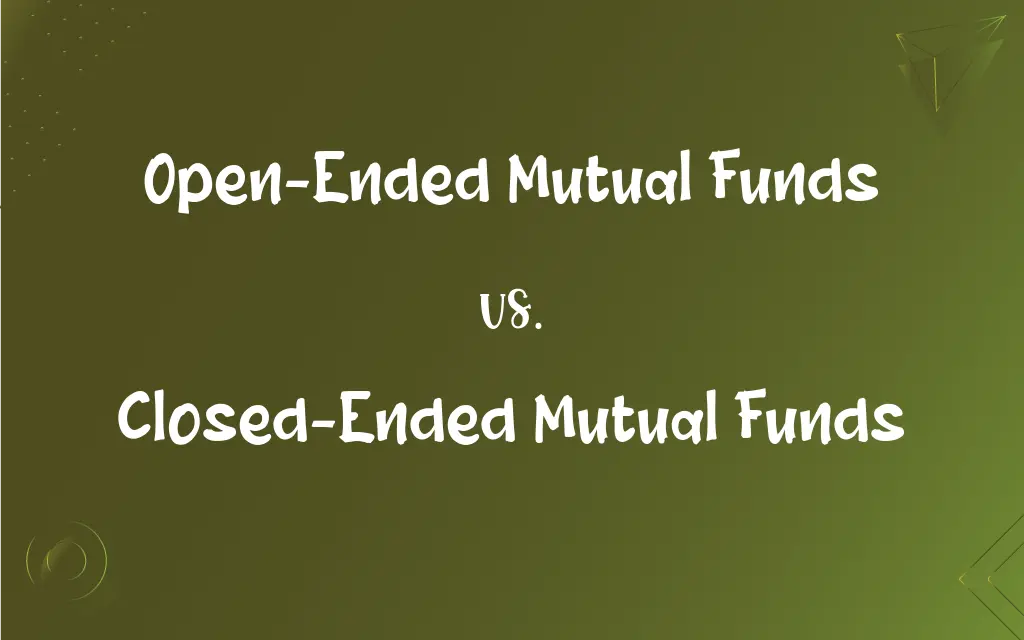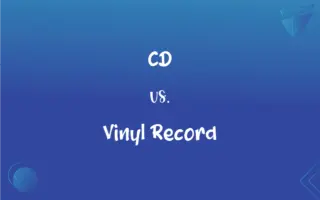Open-Ended Mutual Funds vs. Closed-Ended Mutual Funds: What's the Difference?
Edited by Aimie Carlson || By Janet White || Published on August 19, 2024
Open-ended mutual funds allow unlimited shares and flexible investment/redemption, while closed-ended funds have a fixed number of shares, traded on exchanges.

Key Differences
Open-ended mutual funds offer flexibility in terms of share quantity; they can issue an unlimited number of shares to investors and buy back these shares when investors wish to sell. This means the fund's capital can fluctuate daily based on investors' buying and selling activities. Conversely, closed-ended mutual funds issue a fixed number of shares through an initial public offering (IPO), and these shares are then traded among investors on the stock exchange.
The liquidity of open-ended mutual funds comes directly from the fund itself. If an investor decides to sell their shares, the fund buys back these shares at the net asset value (NAV) calculated at the end of the trading day. For closed-ended mutual funds, liquidity is provided by the stock market, and shares are bought and sold at market prices, which can be above (premium) or below (discount) the NAV.
Open-ended mutual funds are dynamically managed, allowing investors to enter or exit the fund at any time, which aligns with the investors' need for flexibility. This dynamic nature requires fund managers to maintain a cash reserve to meet redemption requests, potentially affecting the fund's investment strategy. Closed-ended mutual funds, with their fixed share count, do not face daily redemption pressures, enabling fund managers to focus on long-term investment strategies without the need to keep a significant cash reserve.
In terms of pricing, open-ended mutual funds' shares are bought and sold at the NAV, ensuring that transactions reflect the underlying assets' value. The trading of closed-ended mutual fund shares on stock exchanges means their market price is determined by supply and demand, leading to prices that can diverge significantly from the NAV.
Comparison Chart
Share Quantity
Unlimited, varies with investor demand
Fixed, determined at IPO
ADVERTISEMENT
Liquidity
Provided by the fund, shares redeemed at NAV
Provided by the market, shares traded at market price
Investment Entry/Exit
Flexible, investors can enter or exit any time
Fixed, after IPO shares are traded on the market
Pricing
At net asset value (NAV)
Market price, can be at a premium or discount to NAV
Management Strategy
Potentially affected by daily cash flow needs
Can focus on long-term investments without frequent redemptions
Open-Ended Mutual Funds and Closed-Ended Mutual Funds Definitions
Open-Ended Mutual Funds
Open-ended mutual funds offer daily redemption of shares at NAV.
She redeemed her shares in the open-ended mutual fund to invest in a different opportunity.
ADVERTISEMENT
Closed-Ended Mutual Funds
Closed-ended mutual funds do not offer daily redemptions.
She had to sell her closed-ended mutual fund shares on the market instead of redeeming them.
Open-Ended Mutual Funds
Open-ended mutual funds provide direct liquidity to investors.
Accessing his money was easy through the open-ended mutual fund, with direct redemption available.
Closed-Ended Mutual Funds
Closed-ended mutual funds are traded on stock exchanges.
He bought shares of the closed-ended mutual fund on the stock exchange.
Open-Ended Mutual Funds
Open-ended mutual funds are valued at the net asset value.
The NAV of her open-ended mutual fund shares was calculated after the market closed.
Closed-Ended Mutual Funds
Closed-ended mutual funds' prices can fluctuate above or below NAV.
The closed-ended mutual fund was trading at a premium to its NAV.
Open-Ended Mutual Funds
Open-ended mutual funds can issue unlimited shares.
Investors appreciate the flexibility of open-ended mutual funds to accommodate new investments anytime.
Closed-Ended Mutual Funds
Closed-ended mutual funds offer long-term investment strategies.
The fund manager focused on long-term gains, benefitting from the closed-ended fund's structure.
Open-Ended Mutual Funds
Open-ended mutual funds adjust their share count based on demand.
The fund's assets grew as more investors bought into the open-ended mutual fund.
Closed-Ended Mutual Funds
Closed-ended mutual funds have a fixed number of shares.
Once issued, the number of shares for the closed-ended mutual fund remained constant.
FAQs
How is the price of open-ended mutual fund shares determined?
The price is based on the net asset value (NAV) per share, calculated at the end of each trading day.
What are open-ended mutual funds?
Open-ended mutual funds are investment funds that continuously issue and redeem shares based on investor demand, with no set limit on the number of shares.
Are open-ended mutual funds regulated?
Yes, they are regulated by financial authorities to protect investors.
Can investors buy and sell shares of open-ended mutual funds at any time?
Yes, investors can buy and sell shares at the NAV, typically at the end of the trading day.
What types of assets do open-ended mutual funds invest in?
They can invest in a variety of assets, including stocks, bonds, and other securities.
What are the advantages of open-ended mutual funds?
Advantages include liquidity, diversification, and professional management.
What is the minimum investment required for open-ended mutual funds?
The minimum investment varies by fund but can be as low as a few hundred dollars.
Do open-ended mutual funds pay dividends?
Yes, many open-ended mutual funds distribute dividends from their investments.
Are closed-ended mutual funds regulated?
Yes, they are regulated by financial authorities to protect investors.
What is the minimum investment required for closed-ended mutual funds?
The minimum investment is typically the price of one share, which varies based on market conditions.
What are the disadvantages of open-ended mutual funds?
Disadvantages include fees, potential tax consequences, and market risk.
What are closed-ended mutual funds?
Closed-ended mutual funds are investment funds with a fixed number of shares that are traded on stock exchanges.
What types of assets do closed-ended mutual funds invest in?
They can invest in a variety of assets, including stocks, bonds, and other securities.
How can investors purchase shares of closed-ended mutual funds?
Investors can purchase shares through a broker or a trading platform.
How can investors purchase shares of open-ended mutual funds?
Investors can purchase shares directly from the fund company or through a broker.
Do closed-ended mutual funds pay dividends?
Yes, many closed-ended mutual funds distribute dividends from their investments.
Can investors buy and sell shares of closed-ended mutual funds at any time?
Yes, investors can trade shares on the stock exchange during trading hours.
What are the advantages of closed-ended mutual funds?
Advantages include the ability to trade at market prices and potentially higher yields.
What are the disadvantages of closed-ended mutual funds?
Disadvantages include the potential for shares to trade at a discount to NAV and less liquidity.
How is the price of closed-ended mutual fund shares determined?
The price is determined by supply and demand in the market, which can lead to shares trading at a premium or discount to NAV.
About Author
Written by
Janet WhiteJanet White has been an esteemed writer and blogger for Difference Wiki. Holding a Master's degree in Science and Medical Journalism from the prestigious Boston University, she has consistently demonstrated her expertise and passion for her field. When she's not immersed in her work, Janet relishes her time exercising, delving into a good book, and cherishing moments with friends and family.
Edited by
Aimie CarlsonAimie Carlson, holding a master's degree in English literature, is a fervent English language enthusiast. She lends her writing talents to Difference Wiki, a prominent website that specializes in comparisons, offering readers insightful analyses that both captivate and inform.







































































